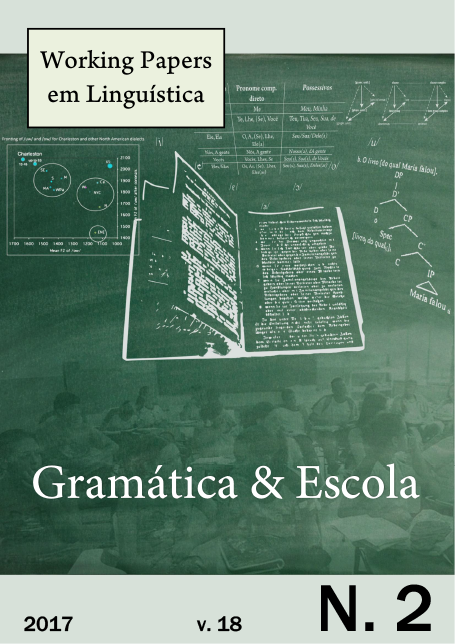Hipercorreções na escrita como evidência da gramática fonológica da criança
DOI:
https://doi.org/10.5007/1984-8420.2017v18n2p153Resumen
O trabalho apresenta uma análise da escrita inicial, buscando identificar evidências da influência de processos fonológicos do português brasileiro no processo de aquisição do código escrito. O foco do trabalho é identificar, na escrita das crianças, indícios de hipercorreção baseada em três fenômenos fonológicos presentes na fala: a harmonia vocálica, o alçamento vocálico e a semivocalização da líquida lateral em posição pós-vocálica. O trabalho parte da seguinte questão: será que no momento em que a criança se depara com o código escrito e percebe que as letras nem sempre apresentam uma relação direta com a forma como são pronunciadas (ou seja, um ‘i’ falado nem sempre será um ‘i’ na escrita), além de corrigir seus erros ortográficos iniciais, elas passam a hipercorrigir suas produções escritas? Além disso, o trabalho busca evidências empíricas de como a gramática fonológica da criança atua na aquisição da escrita ao se esperar que as hipercorreções sejam regidas por restrições da fonologia da língua. A fim de abordarmos essas questões, analisamos dados de escrita inicial de um banco de dados organizado pelo Projeto Aspa da Universidade Federal de Minas Gerais, o E-labore (Laboratório Eletrônico de Oralidade e Escrita) (CRISTÓFARO-SILVA et al., 2009). Os resultados nos mostram que há, sim, hipercorreções relacionadas aos processos fonológicos da língua na aquisição do código escrito e que estas são majoritariamente regidas por restrições fonológicas do português brasileiro.Descargas
Publicado
Número
Sección
Licencia
Os direitos autorais de trabalhos publicados são dos autores, que cedem à Revista Working Papers em Linguística o direito de publicação, ficando sua reimpressão, total ou parcial, sujeita à autorização expressa da Comissão Editorial da revista. Deve ser consignada a fonte de publicação original. Os nomes e endereços de e-mail neste site serão usados exclusivamente para os propósitos da revista, não estando disponíveis para outros fins.
The names and email addresses entered in this journal site will be used exclusively for the stated purposes of this journal and will not be made available for any other purpose or to any other party.
Esta obra está licenciada sob licença Creative Commons - Atribuição-NãoComercial- 4.0 Internacional.


